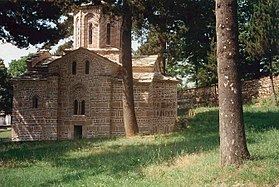 | ||
Similar Serbian Orthodox Church, Church of St Stefan Štiljanovi, Church of St Peter and Paul, Church of the Nativity of the Vir, Church of St Nicholas | ||
The Church of Virgin Hodegetria (Serbian: Црква Богородице Одигитриjе, Albanian: Kisha e Virgjëreshës së Shenjtë në Hodegetri) was a 14th-century Serbian Orthodox church in Kosovo that was destroyed by Kosovar Albanian forces during the destruction of the Serbian part of Mušutište, after the end of the Kosovo war in 1999.
The church was built as a foundation by the court governor (kaznac) Jovan Dragoslav, in 1315, in Mušutište, near Suva Reka. The inscription at the entrance of the church was considered one of the oldest and most accomplished Serbian epigraphic texts of its kind. It was an inscribed-cross church with a semi-dome and a semi-round apse. The wall was built of alternating rows of bricks and stone cubes. The frescoes of the Mušutište School, related to the style of the Palaeologus era, were painted between 1316 and 1320 and were famed for their plasticity and the saints' typology were known as the best examples of Serbian art. In the altar area there was a unique portrait of the South-Slav educator, St Clement of Ohrid. In the north-western corner of the naos there were figures of holy women, the warrior saints Theodore Tyro and Theodore Stratelates, angels, and St Panteleimon. Two throne icons of Christ and The Holy Virgin dated back to the year 1603.
The church was inscribed in the list of the Monument of Culture of Exceptional Importance in 1990.
